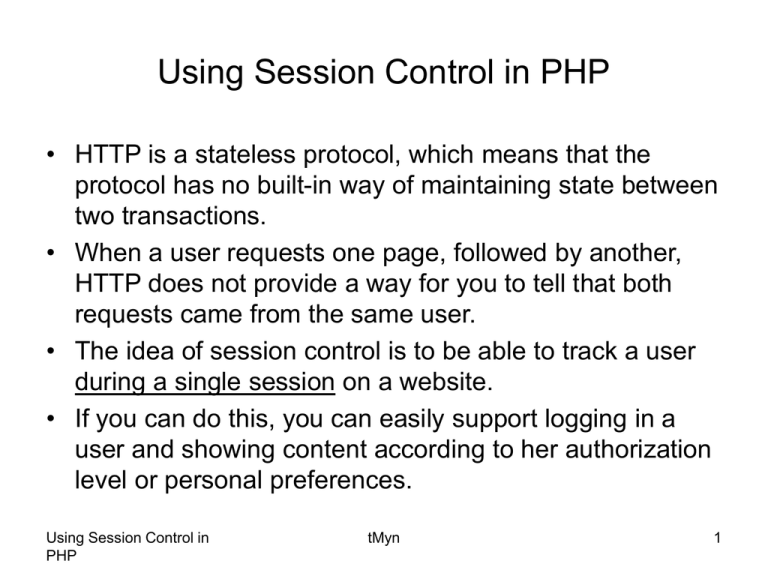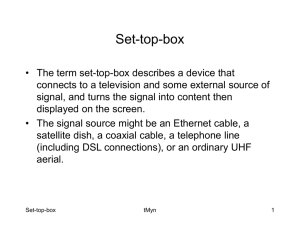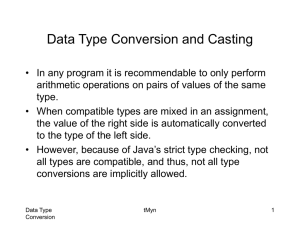Using Session Control in PHP
advertisement

Using Session Control in PHP • HTTP is a stateless protocol, which means that the protocol has no built-in way of maintaining state between two transactions. • When a user requests one page, followed by another, HTTP does not provide a way for you to tell that both requests came from the same user. • The idea of session control is to be able to track a user during a single session on a website. • If you can do this, you can easily support logging in a user and showing content according to her authorization level or personal preferences. Using Session Control in PHP tMyn 1 • Sessions in PHP are driven by a unique session ID, a cryptographically random number. • This session ID is generated by PHP and stored on the client side for the lifetime of a session. • It can be either stored on a user’s computer in a cookie or passed along through URLs. • A session ID acts as a key that allows you to register particular variables as so-called session variables. • The contents of these variables are stored at the server. • The session ID is the only information visible at the client side. Using Session Control in PHP tMyn 2 • If, at the time of a particular connection to your site, the session ID is visible either through a cookie or the URL, you can access the session variables stored on the server for that session. • By default, the session variables are stored in flat files on the server. Using Session Control in PHP tMyn 3 • A cookie is a small piece of information that scripts can store on a client-side machine. • You can manually set cookies in PHP using the setcookie() function. It has the following prototype: bool setcookie(string name [,string value [, int expire [, string path [, string domain [, int secure]]]]) Using Session Control in PHP tMyn 4 • If you set a cookie as setcookie(‘mycookie’, ‘myvalue’); when the user visits the next page in your site (or reloads the current page), you will have access to the cookie via $_COOKIE[‘mycookie’]. • You can delete a cookie by calling setcookie() again with the same cookie name and an expiry time in the past. Using Session Control in PHP tMyn 5 • Cookies have some associated problems: some browsers do not accept cookies, and some users might have disabled cookies in their browsers. • This is one of the reasons PHP sessions use dual cookie/URL method. • When you are using PHP sessions, you do not have to manually set cookies. The session functions take care of this task. • You can use the function session_get_cookie_params() to see the contents of the cookie set by session control. • It returns an array containing the elements lifetime, path, domain, and secure. Using Session Control in PHP tMyn 6 • You can also use session_set_cookie_params($lifetime, $path, $domain [, $secure); • • • • to set the session cookie parameters. PHP uses cookies by default with sessions. If possible, a cookie will be set to store the session ID. The other method it can use is adding the session ID to the URL. Alternatively, you can manually embed the session ID in links so that it is passed along. The session ID is stored in the constant SID. Using Session Control in PHP tMyn 7 • To pass it along manually, you add it to the end of a link similar to a GET parameter: • <a href=“link.php?<?php echo strip_tags(SID); ?>”> Using Session Control in PHP tMyn 8 strip_tags strip_tags — Strip HTML and PHP tags from a string string strip_tags ( string $str [, string $allowable_tags ] ) This function tries to return a string with all HTML and PHP tags stripped from a given str . It uses the same tag stripping state machine as the fgetss() function. str The input string. allowable_tags You can use the optional second parameter to specify tags which should not be stripped. Using Session Control in PHP tMyn 9 • • • • • The basic steps of using sessions are: Starting a session Registering session variables Using session variables Deregistering variables and destroying the session • These steps don’t necessarily all happen in the same script, and some of them happen in multiple scripts. Using Session Control in PHP tMyn 10 session_start — Initialize session data bool session_start ( void ) session_start() creates a session or resumes the current one based on the current session id that's being passed via a request, such as GET, POST, or a cookie. If you want to use a named session, you must call session_name() before calling session_start(). session_start() will register internal output handler for URL rewriting when trans-sid is enabled. This function returns TRUE if session was started with success otherwise FALSE. Using Session Control in PHP tMyn 11 session_id — Get and/or set the current session id string session_id ([ string $id ] ) session_id() is used to get or set the session id for the current session. The constant SID can also be used to retrieve the current name and session id as a string suitable for adding to URLs. id If id is specified, it will replace the current session id. session_id() needs to be called before session_start() for that purpose. Depending on the session handler, not all characters are allowed within the session id. For example, the file session handler only allows characters in the range a-z A-Z 0-9 , (comma) and - (minus)! Note: When using session cookies, specifying an id for session_id() will always send a new cookie when session_start() is called, regardless if the current session id is identical to the one being set. session_id() returns the session id for the current session or the empty string ("") if there is no current session (no current session id exists). Using Session Control in PHP tMyn 12 session_name — Get and/or set the current session name string session_name ([ string $name ] ) session_name() returns the name of the current session. The session name is reset to the default value stored in session.name at request startup time. Thus, you need to call session_name() for every request (and before session_start() or session_register() are called). name The session name references the session id in cookies and URLs. It should contain only alphanumeric characters; it should be short and descriptive (i.e. for users with enabled cookie warnings). If name is specified, the name of the current session is changed to its value. Returns the name of the current session. Using Session Control in PHP tMyn 13 session_unset — Free all session variables void session_unset ( void ) The session_unset() function frees all session variables currently registered. No value is returned. Using Session Control in PHP tMyn 14 session_destroy — Destroys all data registered to a session bool session_destroy ( void ) session_destroy() destroys all of the data associated with the current session. It does not unset any of the global variables associated with the session, or unset the session cookie. To use the session variables again, session_start() has to be called. In order to kill the session altogether, like to log the user out, the session id must also be unset. If a cookie is used to propagate the session id (default behavior), then the session cookie must be deleted. setcookie() may be used for that. Returns TRUE on success or FALSE on failure. Using Session Control in PHP tMyn 15 • Let us study some aspects from our php.ini file: Cookies are enabled: Using Session Control in PHP tMyn 16 The name of the session: Using Session Control in PHP tMyn 17 Starting a session • Before you can use session functionality, you need to actually begin a session. • The simplest way of starting a session is to begin a script with a call to the session_start() function. • This function checks to see whether there is already a current session. If not, it will essentially create one, providing access to the superglobal $_SESSION array. • If a session already exists, session_start() loads the registered session variables so that you can use them. • It is a good idea to call session_start() at the start of all your scripts that use sessions. Using Session Control in PHP tMyn 18 Registering session variables • To create a session variable you set an element in the superglobal array $_SESSION,for example: $_SESSION[‘myvar’]=5; • The session variable you have just created will be tracked until the session ends or until you manually unset it. Using Session Control in PHP tMyn 19 Using session variables • To bring session variables into scope you must first start a session using session_start(). • You can then access the variable via the $_SESSION superglobal array, for example as $_SESSION[‘myvar’]. • If you want to check whether session variables have been set: if(isset($_SESSION[‘myvar’])) … Using Session Control in PHP tMyn 20 Unsetting variables and destroying the session • When you are finished with a session variable, you can unset it: unset($_SESSION[‘myvar’]); • To unset all the session variables at once, use $_SESSION=array(); or session_unset(); Using Session Control in PHP tMyn 21 • When you are finished with a session, you should first unset all the variables and then call session_destroy(); to clean up the session ID. Using Session Control in PHP tMyn 22 • In the first example we start a session and create the variable $_SESSION[‘counter’] as a session variable. • When we open the page for the first time, the variable $_SESSION[‘counter’] will get the value 1. • When the user goes to some other page and comes back to this original page, the value of the variable $_SESSION[‘counter’] will be incremented. • Session remains current as long as the browser is active. When the user restarts the browser, the persistent value of $_SESSION[‘counter’] can no more be accessed. Using Session Control in PHP tMyn 23 Using Session Control in PHP tMyn 24 Using Session Control in PHP tMyn 25 • After a session is started, you instantly have access to the user’s session ID via the session_id() function. • If the page is later reloaded or revisited (during the same session), the same session ID is allocated to the user. This allocation assumes that the user has cookies enabled. Using Session Control in PHP tMyn 26 • In the php.ini file there are some configuration options, one of them is session.name, where the default value is PHPSESSID. It sets the name of the session that is used as the cookie name on a user’s system. • Next example demonstrates those aspects: Using Session Control in PHP tMyn 27 Using Session Control in PHP tMyn 28 Using Session Control in PHP tMyn 29 • Explanation to the previous slide: there could not be any value for the $PHPSESSID variable. Based on that information a new session will be created. • PHP writes to a temporary file, C:\Windows\temp. The name of the file is sess_xyz, where xyz equals to the session ID that was allocated when the script was run for the first time: Using Session Control in PHP tMyn 30 Using Session Control in PHP tMyn 31 • Next simple example implements a set of three pages. • On the first page, start a session and create the session variable $_SESSION['sessionVariable']: Using Session Control in PHP tMyn 32 Using Session Control in PHP tMyn 33 • This script creates the session variable and sets its value. The output of the script: Using Session Control in PHP tMyn 34 Using Session Control in PHP tMyn 35 • The final value of the variable on the previous page is the one that will be available on subsequent pages. • At the end of the script, the session variable is serialized, or frozen, until it is reloaded via the next call to session_start(). • Serialize: to generate a storable representation of a value • You can therefore begin the next script by calling session_start(): Using Session Control in PHP tMyn 36 Using Session Control in PHP tMyn 37 • After you call session_start(), the variable $_SESSION['sessionVariable'] is available with its previously stored value: Using Session Control in PHP tMyn 38 Using Session Control in PHP tMyn 39 • After you have used the variable, you unset it. The session still exists, but the variable no longer exists Using Session Control in PHP tMyn 40 unset — Unset a given variable void unset ( mixed $var [, mixed $var [, mixed $... ]] ) unset() destroys the specified variables. The behavior of unset() inside of a function can vary depending on what type of variable you are attempting to destroy. If a globalized variable is unset() inside of a function, only the local variable is destroyed. The variable in the calling environment will retain the same value as before unset() was called. Parameters var The variable to be unset. var Another variable .. ... No value is returned. Using Session Control in PHP tMyn 41 • Finally, you pass along to page C, the final script in the example: Using Session Control in PHP tMyn 42 Using Session Control in PHP tMyn 43 • As we can see, we no longer have access to the persistent value of $_SESSION['sessionVariable']: Using Session Control in PHP tMyn 44 Using Session Control in PHP tMyn 45 • You finish by calling session_destroy() to dispose of session ID. Using Session Control in PHP tMyn 46





